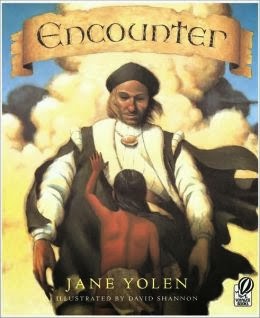"In fourteen hundred ninety-two
Columbus sailed the ocean blue.
He had three ships and left from Spain;
He sailed through sunshine, wind and rain.
He sailed by night; he sailed by day;
He used the stars to find his way.
A compass also helped him know
How to find the way to go.
Ninety sailors were on board;
Some men worked while others snored.
Then the workers went to sleep;
And others watched the ocean deep.
Day after day they looked for land;
They dreamed of trees and rocks and sand.
October 12 their dream came true,
You never saw a happier crew!
"Indians! Indians!" Columbus cried;
His heart was filled with joyful pride.
But "India" the land was not;
It was the Bahamas, and it was hot.
The Arakawa natives were very nice;
They gave the sailors food and spice.
Columbus sailed on to find some gold
To bring back home, as he'd been told.
He made the trip again and again,
Trading gold to bring to Spain.
The first American? No, not quite.
But Columbus was brave, and he was bright."
Columbus sailed the ocean blue.
He had three ships and left from Spain;
He sailed through sunshine, wind and rain.
He sailed by night; he sailed by day;
He used the stars to find his way.
A compass also helped him know
How to find the way to go.
Ninety sailors were on board;
Some men worked while others snored.
Then the workers went to sleep;
And others watched the ocean deep.
Day after day they looked for land;
They dreamed of trees and rocks and sand.
October 12 their dream came true,
You never saw a happier crew!
"Indians! Indians!" Columbus cried;
His heart was filled with joyful pride.
But "India" the land was not;
It was the Bahamas, and it was hot.
The Arakawa natives were very nice;
They gave the sailors food and spice.
Columbus sailed on to find some gold
To bring back home, as he'd been told.
He made the trip again and again,
Trading gold to bring to Spain.
The first American? No, not quite.
But Columbus was brave, and he was bright."
(Author Unknown)
With this infamous poem, websites tout that you can "teach history through song." It's true. History can be taught through song, but what if the information taught is inaccurate? Winston Churchill said, "History is written by the victors." What if history was told from another perspective...if it was relayed by the not-so-victorious? What lessons would we learn then?
The second Monday of each October is marked on calendars as "Columbus Day." Therefore, it is a day to celebrate, right? Government offices and schools are often closed, children are taught the same poem year after year, and Christopher Columbus is hailed as the discoverer of America...a great American hero. The Taino would have likely had a very different story. On October 14, 1492, when Columbus arrived in the "New World," there were "originally some 300,000 native islanders [Taino], by 1548--a little more than 50 years later--less than 500 remained. Today, there are no full-blooded Taino" (Jane Yolen). So, the question remains....was Columbus a hero or a villain?
Regardless of one's opinion, what is truly important is that, when learning history, one is taught from an early age that there is more than one side to every story. History curriculum can alter one's perception of historical time periods, and for this reason, when Columbus day rolls around each year, I enjoy sharing the story Encounter by Jane Yolen. As Publishers Weekly relays, "The credible and moving [story] provides a closely woven fabric of revisionist history and superlative storytelling." The story forces one to reflect upon the not-so-victorious and to ponder history from another vantage point, and so at Homeschool Schmidt, we did not focus on the traditional 1492 poem. We did not sing of how Columbus sailed the ocean blue, but we did snuggle up on the couch and read Encounter. In doing so, I hope that I have begun the process of instilling in our children that there are always two sides to every story...and that, oftentimes, we can learn more from the not-so-victorious than from the victors.

No comments:
Post a Comment